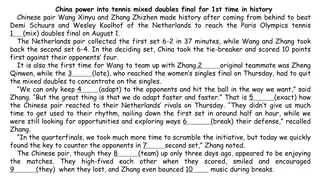
IEEE 802.11ax Channel Sounding Implementation in ns-3
Explore the Implementation and Evaluation of IEEE 802.11ax Channel Sounding Frame Exchange in ns-3 for MIMO simulations and upcoming IEEE 802.11be coordination schemes. Detailed contributions include MAC layer enhancements, frame exchange logic, and multi-user scheduling for MU-MIMO capabilities.
Download Presentation

Please find below an Image/Link to download the presentation.
The content on the website is provided AS IS for your information and personal use only. It may not be sold, licensed, or shared on other websites without obtaining consent from the author. If you encounter any issues during the download, it is possible that the publisher has removed the file from their server.
You are allowed to download the files provided on this website for personal or commercial use, subject to the condition that they are used lawfully. All files are the property of their respective owners.
The content on the website is provided AS IS for your information and personal use only. It may not be sold, licensed, or shared on other websites without obtaining consent from the author.
E N D
Presentation Transcript
WNS3 2023, June 2829, 2023, Arlington, VA, USA Implementation and Evaluation of IEEE 802.11ax Channel Sounding Frame Exchange in ns-3 Jingyuan Zhang School of ECE Georgia Institute of Technology Stefano Avallone Computer Engineering Department University of Naples Douglas M. Blough School of ECE Georgia Institute of Technology
Background Missing feature of MU-MIMO in ns-3 - No functionality of CSI feedback Reasons for adding channel sounding in ns-3 - Channel sounding is a critical step to implement MIMO-related simulation (beamforming, multi- user MIMO) in IEEE 802.11ax. - Instantaneous channel matrix is a key component for coordinated null steering, which is one of multi-AP coordination schemes for upcoming IEEE 802.11be.
Contributions Implementation of channel sounding frame exchange in MAC layer based on IEEE 802.11ax - Functionality to generate new frames in ns-3 that are required for channel sounding - Frame exchange logic for channel sounding for both single-user (SU) and multi-user (MU) cases - Functionality to generate well-structured beamforming reports with various choices of CSI resolutions and quantity according to IEEE 802.11ax - A simple multi-user scheduler for MU-MIMO, which selects users for channel sounding and MU-MIMO data transmission.
Preliminaries Channel Sounding in IEEE 802.11ax Single-user case: Multi-user case:
Preliminaries Frame Formats NDPA frame format STA Info: - Resource unit (RU) range - Number of columns in compressed beamforming matrix - Subcarrier grouping - Codebook size Compressed Beamforming Report frame
Implementation of Channel Sounding Protocol HeConfiguration, HeCapabilities, WifiMac HE Capability configuration Code Structure CtrlTriggerUserInfoField, CtrlNdpaHeader (new), WifiActionHeader, HeMimoControlHeader (new), HeCompressedBfReport(new), HeMuExclusiveBfReport (new) Structures of new frames HeFrameExchangeManager, RrMultiUserScheduler, MultiUserScheduler, HeRu, WifiTxTimer Frame exchange and user scheduling Management of channel information and channel sounding frames ChannelSounding (new), CsBeamformer (new), CsBeamformee (new) ns-3 WiFi module framework Modified and added classes
Implementation of Channel Sounding Protocol HE Capability Configuration HE PHY Capabilities Information fields related to channel sounding in IEEE 802.11ax: - Ng = 16 SU Feedback - Ng = 16 MU Feedback - Codebook Size ( , ) = {4, 2} SU Feedback - Codebook Size ( , ) = {7, 5} MU Feedback - Max Nc Contribution: - The above 5 attributes are added in the class of HeConfiguration. - ns-3 users are allowed to configure these parameters by calling SetAttribute().
Implementation of Channel Sounding Protocol New Frames - NDPA Frame (Control frame) New Frames BFRP Trigger Frame (Control frame) NDPA header New member variable in CtrlTriggerUserInfoField: - m_bfrpTriggerDependentUserInfo Main methods: - SetBfrpTriggerDepUserInfo - GetBfrpTriggerDepUserInfo A new class called CtrlNdpaHeader is added in ctrl- header.h and ctrl-header.cc. Member variables: - m_dialogToken: the field of Sounding Dialog Token - m_staInfoFields: STA Info fields Main methods: - AddStaInfoField - FindStaInfoWithAid
Implementation of Channel Sounding Protocol New Frames - Beamforming Report Frame (Management frame) HeMimoControlHeader - Built based on STA Info field in NDPA frame HeCompressedBfReport - Built based on HE MIMO Control field and channel information HeMuExclusiveBfReport - Built based on HE MIMO Control field and channel information
Implementation of Channel Sounding Protocol Management of Channel Information and Channel Sounding Frames Channel information struct: ChannelInfo: { m_stStreamSnr, m_phi, m_psi, m_deltaSnr} ChannelSounding (Base class) Main member variables: - m_channelInfoList: a list of struct ChannelInfo storing acquired CSI Main methods: - GenerateNdpaFrame - GetBfReportInfo - CheckAllChannelInfoReceived - CheckChannelSounding CsBeamformer (Derived class) Main member variables: - m_heMimoControlHeader - m_channelInfo CsBeamformee (Derived class) Main methods: - CalculateChannelInfo - GetNdpaInfo - GetNdpInfo - GenerateBfReport
Implementation of Channel Sounding Protocol Multi-User Scheduling Primary goal: Schedule as many stations as possible in the current TXOP RrMultiUserScheduler::TryChannelSounding() Channel sounding scheduling - Add stations one by one until the estimated duration of the channel sounding process exceeds the current TXOP or the maximum number of supported users is reached - Allocate equal-sized RUs to various stations in MU case - Generate NDPA frame, NDP frame and BFRP trigger frame (if it is an MU case) MU-MIMO data transmission scheduling Schedule MU-MIMO data transmission in the current TXOP if there is remaining time in the current TXOP after channel sounding is completed. Schedule MU-MIMO data transmission in a new TXOP if the is remaining time in current TXOP is not enough. - -
Implementation of Channel Sounding Protocol Frame Exchange Process AP side Station side
Simulation - Impact of Channel Sounding on Latency Worst-Case Channel Sounding Duration vs. Number of Stations The sounding duration is short for the single-user case, while the duration is non-negligible with 3 and 4 stations. The sounding duration generally decreases as the channel bandwidth increases. Sounding Duration vs. Number of Stations (Nr = 4, Nc = 4, Ng = 4, Codebook Size = (6,4) and (9,7), HE MCS0)
Simulation - Impact of Channel Sounding on Latency Worst-Case Channel Sounding Duration vs. Size of Compressed Beamforming Feedback Matrix Sounding duration increase when the matrix size increases from (2, 1) to (4, 4): - 140% increase in SU case - nearly 300% in the MU case SU case vs. MU case - HE MU Exclusive Beamforming Report field Sounding Feedback Matrix (?? , ?? ) (Bandwidth = 160MHz, Ng = 4, Codebook Size = (6,4) and (9,7), HE MCS0, 4 Stations for MU Case) Duration vs. Size of beamforming
Simulation - Impact of Channel Sounding on Latency Overhead Reduction by Adjustment of Subcarrier Grouping Overhead Reduction by Adjustment of Codebook Size Sounding Duration vs. Codebook Size (Bandwidth = 160MHz, Ng = 4, HE MCS0, 4 Stations for MU Case) Sounding Duration vs. Subcarrier Grouping (Bandwidth = 160MHz, Codebook Size = (6,4) and (9,7), HE MCS0, 4 Stations for MU Case) It is more effective to reduce channel sounding duration by tuning the subcarrier grouping than the codebook size.
Simulation - Impact of Channel Sounding on Latency Overhead Reduction with Higher MCS Levels Duration reduction when MCS increases from HE MCS0 to HE MCS11: - 65% reduction in SU case - 85% reduction in MU case Sounding Duration vs. MCS (Bandwidth = 160MHz, Ng = 4, Codebook Size = (6,4) and (9,7), 4 Stations for MU Case)
Simulation - Impact of Channel Sounding on Throughput Throughput vs. Channel Sounding Intervals (c) Scenario 3: 1 station with 2 streams, (?? , ?? ) = (4, 2) (a) Scenario 1: 2 stations with 1 stream per station, (?? , ?? ) = (4, 1) (b) Scenario 2: 2 stations with 2 streams per station (only 1 station is selected for downlink data transmission), (?? , ?? ) = (4, 2) The throughput drops monotonically as the channel sounding interval becomes shorter. The greatest impact on throughput occurs for Scenario 2, because it is MU case and it has the largest channel matrix feedback.
Simulation - Impact of Channel Sounding on Throughput Throughput vs. MCS level (a) HE MCS 4 is used for beamforming report feedback (b) Same HE MCS is used for beamforming report feedback and MU-MIMO data transmission If the power constraint at users is not considered and a higher MCS level is used for both uplink CSI feedback and downlink data transmission, there is very little additional benefit, as compared to using HE MCS4 for beamforming report frames.
Conclusions Implementation of MAC-layer CSI feedback process in ns-3: - New channel sounding frames - Frame exchange logic in both SU and MU cases - Multi-user scheduler for channel sounding and MU-MIMO data transmission Evaluation of channel sounding overhead and impact of channel sounding on network throughput






















